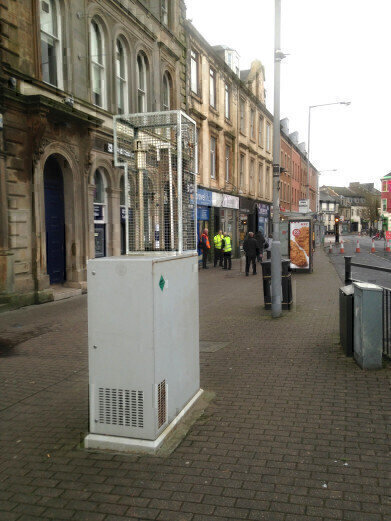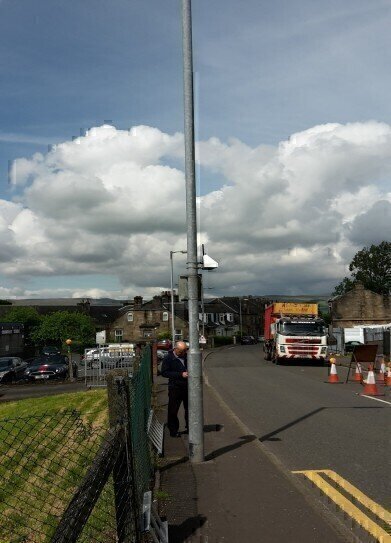Air Monitoring
Monitors Inform local Air Quality Management Strategy
Jan 16 2018
In North Ayrshire, Scotland, monitoring activities have demonstrated that the main local air quality issues are related to traffic congestion caused by a section of the High Street in Irvine, which is being used as a bus terminus, and by queuing traffic at New Street in Dalry. In both locations the pollutant of most concern is Nitrogen Dioxide.
North Ayrshire Council operates a fixed continuous air quality monitoring station (AQMS) in Irvine High Street which supplies data to the www.scottishairquality.co.uk website. “Data from the AQMS is supplemented by portable monitoring equipment that is installed at key locations,” reports the Council’s Willie McNish. “Passive diffusion tubes provide approximate monthly average data, but over the last 2-3 years we have started using AQMesh air quality monitors. Three ‘pods’ have been installed in pollution hotspots and a further AQMesh pod is used as a mobile device; installed temporarily in key locations to assist with air quality strategy development, and planning and development control.”
AQMesh air quality monitoring pods are small, lightweight, wireless, battery or solar -powered air quality monitors that are quick and easy to install. They are able to monitor the main pollutants simultaneously, delivering accurate cloud-based data wirelessly via the internet. “We use the AQMesh pods for air quality screening,” reports Willie McNish, one of the Council’s Officers responsible for air quality monitoring. “The beauty of these monitors is that they provide almost real-time data that we can access via PC. This is really useful for detecting and predicting trends. For example, I can look at the current air quality measured by a pod and then look at the Met Office website for information on wind speed and direction, and this helps us to better understand the factors that affect air quality.”
The ease and speed with which AQMesh pods can be installed in almost any location is a major advantage in air quality investigations related to planning applications. For example, Willie says: “Concerns about dust and fumes from trucks were raised in connection with an application to extend the life of a landfill site by ten years (as less waste is being landfilled more time was required to fill it), but by locating an AQMesh pod (measuring gases and particulates) in an appropriate location, we were able to support the planning decision by demonstrating that air quality would not be harmed by the extension.”
Monitoring is also informing the development of traffic management strategies to reduce exposure to air pollution. In Irvine, Willie says: “The prevailing wind direction is from the South West, which creates a canyon effect, whereby air pollution accumulates within streets that are confined by buildings on both sides. This effect is exacerbated by queuing double-decker buses, so we plan to undertake remedial measures and monitor their effects.”
As a consequence of the elevated levels of Nitrogen Dioxide in Irvine, the Council will undertake public realm works (streetscape improvements) to widen the pavement, and one of the bus stops will be relocated. This will not only move the source of pollution away from the receptor, but also allow better dilution and dispersion of pollutants, without affecting the frequency of service or convenient access to public transport. In Dalry, a new bypass is due to be constructed and it is anticipated that this will lower Nitrogen Dioxide levels. In both locations, modelling has indicated that air quality will improve, but existing monitoring data will be compared with data once the work is complete, so that an effective evaluation of the effects on air quality can be performed.
Summarising the advantages of the Council’s air quality monitoring strategy, Willie says: “The AQMS in Irvine employs standard reference methods or equivalent, to measure air quality, so it is able to provide definitive data for comparison with EU limits. The station is serviced and maintained by Air Monitors and delivers extremely high levels of data capture. Since 2015 it has also included a FIDAS 200 particulate monitor, so we are now able to monitor TSP, PM10, PM4, PM2.5, PM1 and Particle Number simultaneously, which provides greater insight into the types of pollution and their likely sources.
“To complement the AQMS we also operate 4 AQMesh pods which provide the flexibility we need to monitor air quality in precisely the location of greatest importance. Web connectivity combined with Air Monitors’ reliability of service provides us with continuous access to accurate air quality data, which means that we are able to fulfil our statutory obligations as a Council, and also find ways to protect the health of people in North Ayrshire.”
Digital Edition
IET 34.2 March 2024
April 2024
Gas Detection - Biogas batch fermentation system for laboratory use with automatic gas analysis in real time Water/Wastewater - Upcycling sensors for sustainable nature management - Prist...
View all digital editions
Events
Apr 22 2024 Hannover, Germany
Apr 22 2024 Marrakech, Morroco
Apr 23 2024 Kuala Lumpur, Malaysia
Apr 23 2024 Kintex, South Korea
Apr 23 2024 Edmonton, AB, Canada



















